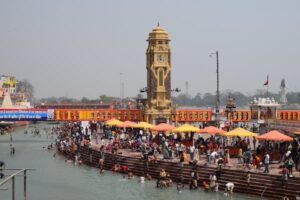Haridwar : Har Ki Pauri
“Har Ki Pauri: The Sacred Ghat of Haridwar”
Nestled along the banks of the holy Ganges River in the northern Indian state of Uttarakhand, Haridwar stands as a testament to the spiritual and cultural richness of India. Within this ancient city lies a place of immense significance and reverence, “Har Ki Pauri,” which translates to “Footsteps of the Lord.” This sacred ghat, or bathing steps, is not just a location; it’s a divine experience, a portal to the sacred, and a testament to the enduring legacy of India’s religious traditions.
A Divine Gathering Place
Har Ki Pauri is not just a geographical location; it’s a spiritual hub that has drawn pilgrims, seekers, and wanderers for centuries. It is believed to be the precise spot where Lord Vishnu left his footprint, and it’s this sacred imprint that gives the ghat its name and significance.
The ghat is a bustling center of activity, especially during the Kumbh Mela, a major Hindu festival that draws millions of devotees from all corners of India and beyond. During this holy gathering, the ghat witnesses a spectacle of devotion, with devotees taking a dip in the Ganges to cleanse themselves of sins and attain spiritual purification.
The Evening Ganga Aarti: A Mesmerizing Ritual
One of the most enchanting and revered rituals at Har Ki Pauri is the evening Ganga Aarti. As the sun sets, the ghat comes alive with the resonant sounds of temple bells and the chanting of prayers. Devotees and tourists alike gather to witness the mesmerizing performance, a beautiful fusion of fire and water that pays homage to the Ganges River, often referred to as “Maa Ganga” or Mother Ganges.
The Aarti involves the synchronized movements of priests who hold large lamps, creating a breathtaking dance of light and shadow. As they offer prayers to the river, the fragrance of incense and the melody of devotional songs fill the air. The river’s surface is adorned with floating lamps and flower offerings, creating a luminous spectacle that reflects the spiritual energy of the place.

Bathing in the Holy Ganges
The primary reason pilgrims and visitors flock to Har Ki Pauri is for the holy dip in the Ganges. Hindus believe that bathing in the sacred waters of the Ganges River at this ghat can wash away their sins and grant them spiritual salvation. Devotees and tourists from all walks of life stand shoulder to shoulder as they immerse themselves in the river, seeking a connection with the divine.
The experience is more than just a physical cleansing; it is a profound spiritual journey. The Ganges River, with its significance in Hindu mythology and its pristine, flowing waters, is believed to carry the blessings of the divine. Each dip represents a moment of rebirth and a step towards purification.
A Glimpse into History
Har Ki Pauri isn’t just a place of religious importance; it’s also a site steeped in history. Its construction dates back to King Vikramaditya of Ujjain in the 1st century BC. Over the centuries, it has been renovated and expanded, but it still retains its ancient charm and sacred aura.
One of the iconic structures at the ghat is the Brahmakund, a large rectangular tank filled with water from the Ganges. It is believed that Lord Brahma himself performed a yagna (fire ritual) at this spot. This ancient tank is surrounded by various temples, each with its unique history and significance.
Har Ki Pauri and the Pilgrim’s Journey
For many devout Hindus, a visit to Har Ki Pauri is an integral part of their spiritual journey. Pilgrims often come from distant corners of India, and for some, it’s a once-in-a-lifetime experience. They come with offerings, prayers, and a deep sense of devotion, hoping to find solace and divine blessings on the sacred banks of the Ganges.
The ghat is a place where people come to seek answers, to reflect on their lives, and to connect with the divine. It’s a space where personal stories intermingle with the grand tapestry of India’s spiritual heritage.
Preserving the Legacy of Har Ki Pauri
The significance of Har Ki Pauri goes beyond religious rituals; it’s a cultural heritage and a symbol of India’s spiritual diversity. Efforts are made to preserve the ghat and its historical structures. The beauty and purity of the Ganges River, however, remain threatened by pollution and environmental challenges. Various initiatives and awareness campaigns are ongoing to protect and preserve this sacred site.
In conclusion, Har Ki Pauri is not merely a physical place; it is a bridge between the earthly and the divine. It’s a testament to the unshakable faith of millions and a tribute to India’s rich cultural and spiritual traditions. Whether you are a seeker of the divine, a traveler with wanderlust, or a curious explorer, a visit to Har Ki Pauri in Haridwar is an experience that can be truly transformative, leaving an indelible mark on your soul.
“Ganges Aarti at Har Ki Pauri: A Divine Experience”
In the heart of the ancient Indian city of Haridwar, nestled on the banks of the sacred Ganges River, lies a place that radiates an aura of spirituality and divine connection. Har Ki Pauri, which translates to “Footsteps of the Lord,” is a ghat with profound religious significance. But what elevates this place to the realm of the ethereal is the enchanting and mesmerizing Ganges Aarti that takes place here. It is a sacred ritual that transcends time, a spectacle of fire, water, and devotion, and a divine experience that leaves an indelible mark on the soul.

Har Ki Pauri: A Sacred Portal
Har Ki Pauri, with its historical and mythological significance, is one of the holiest places in India. It is believed to be the precise spot where Lord Vishnu left his footprint, and this sacred imprint gave the ghat its name. Located in the heart of Haridwar, the ghat has drawn pilgrims and seekers for centuries, and it is not only a place of religious devotion but also a symbol of India’s rich cultural heritage.
The Ganges River, known as “Maa Ganga” or Mother Ganges, is revered in Hinduism for its purifying and life-giving properties. The Ganges Aarti at Har Ki Pauri is a profound expression of this reverence, a ritual that pays homage to the divine river and connects the worshipper with the sacred.
The Evening Ganges Aarti: A Visual Symphony
As the sun begins its descent in the evening, Har Ki Pauri undergoes a transformation. Pilgrims and visitors gather in anticipation, the atmosphere buzzing with a palpable sense of devotion. The rhythmic ringing of temple bells, the scent of incense, and the distant chants of prayers set the stage for the Ganges Aarti, a spectacle that marries fire and water in an intricate dance.
The Aarti is performed by a group of skilled priests, clad in saffron robes. They move in perfect harmony, holding large oil lamps and offering synchronized prayers. The lamps, or “diyas,” are beautifully adorned with flowers and are lit in unison. The reflections of the flames on the river’s surface create a mesmerizing play of light and shadow, adding to the ethereal quality of the ritual.
A Ritual of Devotion and Gratitude
The Ganges Aarti is not merely a performance; it is an act of devotion and gratitude. It is an expression of the worshippers’ deep reverence for the Ganges, which is considered the giver of life and the remover of sins. The prayers offered during the Aarti seek blessings for the well-being and prosperity of all living beings.
Devotional songs, known as bhajans, are sung during the Aarti, adding a melodious and spiritual dimension to the ceremony. The bhajans are typically dedicated to the Ganges River and express the profound connection between the river and the people who depend on its life-giving waters.
The Floating Lamps and Floral Offerings
One of the most enchanting aspects of the Ganges Aarti is the floating lamps and floral offerings. Devotees and priests release small lamps made of leaves and flowers into the Ganges, allowing them to float downstream. These offerings symbolize the worshipper’s desire to let go of their material attachments and seek spiritual enlightenment.
As the lamps gently drift away, they create a luminous trail on the dark water, mirroring the concept of life’s journey, which ultimately leads to spiritual illumination. It is a powerful and symbolic representation of the human quest for spiritual awakening and liberation from the cycle of birth and death.
A Spiritual Connection with the Divine
For the thousands of devotees and visitors who gather at Har Ki Pauri for the Ganges Aarti, the experience is not limited to the visual and auditory. It is a moment of deep spiritual connection, a feeling of oneness with the divine and the river that embodies it.
The Ganges Aarti is an opportunity to offer one’s prayers, to reflect on one’s own spiritual journey, and to seek blessings for the future. Whether you are a devout pilgrim or a curious traveler, the Aarti transcends religious boundaries and touches the hearts of all who witness it.
The Significance of Fire and Water
The elemental significance of the Ganges Aarti is striking. Fire, representing purification, transformation, and divine energy, is juxtaposed with the water of the Ganges, which symbolizes life, sustenance, and the source of all creation. The union of these elements in the Aarti mirrors the duality and interconnectedness of life itself.
The Aarti also serves as a reminder of the Ganges’ crucial role in the spiritual and physical well-being of the Indian subcontinent. Its waters are not only a source of nourishment but also a symbol of hope, purity, and rejuvenation.
An Experience That Leaves an Impression
The Ganges Aarti at Har Ki Pauri is an experience that leaves a lasting impression. The radiant and tranquil atmosphere, the captivating visual display, and the spiritual resonance of the ritual make it a unique and unforgettable event. For many, witnessing the Aarti is a moment of deep spiritual awakening, an opportunity to find solace, and a chance to connect with the divine.
It is a tradition that transcends the boundaries of religion, inviting people of all backgrounds to partake in its beauty and significance. The Aarti at Har Ki Pauri is a divine experience that continues to enchant and inspire all who have the privilege of witnessing it, leaving them with a deeper appreciation for the profound spirituality that India so gracefully embraces.
“Haridwar’s Har Ki Pauri: A Gateway to Spiritual Enlightenment”
In the heart of the Indian state of Uttarakhand, along the sacred banks of the Ganges River, lies the ancient city of Haridwar. Here, spirituality weaves its way into every aspect of life, and within this mystical tapestry stands a place of profound significance and spiritual resonance—Har Ki Pauri. This revered ghat, often referred to as the “Footsteps of the Lord,” serves as a gateway to spiritual enlightenment and a conduit for seekers from around the world to connect with the divine.
Har Ki Pauri: A Tapestry of Spirituality
The name “Har Ki Pauri” derives its significance from the belief that Lord Vishnu left his footprint here, marking this location as a place of divine connection. Pilgrims and spiritual seekers have journeyed to this ghat for centuries, and it has become a symbol of India’s deep-rooted spiritual heritage.
At the core of Har Ki Pauri is the Ganges River, known as “Maa Ganga” or Mother Ganges. Its pure and pristine waters are revered in Hinduism for their purifying properties and life-giving force. Har Ki Pauri is a place where the spiritual and the natural world merge, creating a profound sense of interconnectedness.

A Mosaic of Spiritual Practices
Har Ki Pauri is not bound by a singular religious practice; it is a mosaic of various spiritual rituals and traditions. Devotees, yogis, and seekers of different paths gather here to perform their spiritual practices. The ghat serves as a meeting point for the devout and the curious, where all are welcome to partake in the spiritual energy that permeates the air.
One of the most iconic and mesmerizing rituals at Har Ki Pauri is the Ganga Aarti, an event that draws people of all faiths and backgrounds. The Ganga Aarti is a harmonious blend of fire and water, a visual symphony that pays homage to the sacred river and connects the worshipper with the divine.
A Ganga Aarti Like No Other
The Ganga Aarti at Har Ki Pauri is a visual spectacle that transcends the ordinary. As the sun sets, the ghat undergoes a transformation. The resonance of temple bells, the scent of incense, and the rhythmic chanting of prayers fill the air. Devotees and visitors gather in anticipation, their hearts filled with reverence.
A group of skilled priests, draped in saffron robes, perform the Aarti. Holding large oil lamps, or “diyas,” they move in perfect unison, creating a dance of light and shadow. The lamps are exquisitely adorned with flowers, and the collective flickering flames paint a mesmerizing picture on the surface of the Ganges.
Seeking Blessings and Purification
The Ganga Aarti is not a mere spectacle; it is an act of devotion and a means to seek blessings and purification. It is a ritual in which the devotees express their deep reverence for the Ganges, believed to be the giver of life and the remover of sins. The prayers offered during the Aarti seek well-being and prosperity for all living beings.
Devotional songs, or bhajans, add a musical and spiritual layer to the ceremony. These songs are dedicated to the Ganges River and reflect the profound connection between the river and the people who depend on its life-giving waters.
Floating Lamps and Symbolic Offerings
A poignant aspect of the Ganga Aarti is the release of floating lamps and floral offerings into the Ganges. These lamps, made of leaves and flowers, symbolize the worshipper’s desire to let go of their material attachments and seek spiritual enlightenment. As the lamps gently drift downstream, they create a luminous trail, representing the journey of life and the search for spiritual illumination.
This symbolic act reinforces the idea of transcending the worldly attachments and embarking on a spiritual journey. It is a powerful visual metaphor that resonates deeply with those who seek spiritual growth and enlightenment.
A Spiritual Connection with the Divine
The Ganga Aarti at Har Ki Pauri transcends the boundaries of religion and belief systems. It is an experience that leaves a profound spiritual impact on all who witness it. The luminous dance of flames, the meditative chants, and the tranquil ambience create a deep connection with the divine.
Devotees find solace, seekers experience a sense of oneness, and travelers come away with an enduring memory of a divine encounter. The Aarti is a reminder that the search for spiritual enlightenment can be a shared experience that transcends individual faiths and backgrounds.

Preserving the Spiritual Legacy
As the centuries pass, efforts are made to preserve the spiritual legacy of Har Ki Pauri. The ghat and its historical structures bear witness to the countless seekers who have passed through its sacred precincts. Maintaining the purity of the Ganges River, however, remains an ongoing challenge due to pollution and environmental threats.
Awareness campaigns and initiatives are aimed at protecting and preserving this spiritual oasis. The significance of Har Ki Pauri, both culturally and spiritually, underscores the importance of safeguarding its sanctity for future generations.
A Gateway to Spiritual Enlightenment
Har Ki Pauri is a place where time seems to stand still, and the sacred and the natural world harmonize. It is a portal to spiritual enlightenment, a place where seekers connect with the divine and find a profound sense of inner peace.
The Ganga Aarti at Har Ki Pauri is a vibrant expression of India’s spiritual diversity and a testament to the enduring quest for enlightenment. Whether you are a pilgrim, a traveler, or a seeker, a visit to Har Ki Pauri in Haridwar is an opportunity to be touched by the spiritual essence of India and to embark on a journey of self-discovery and spiritual awakening.
Certainly, you can include content about artificial intelligence (AI) in your blog about Har Ki Pauri by discussing how technology and AI are being used in and around this sacred site. Here’s a section you can add to your blog:
AI and Technology at Har Ki Pauri
In the serene and spiritually charged atmosphere of Har Ki Pauri, it might seem surprising to think about the integration of modern technology, particularly artificial intelligence (AI). However, in recent years, AI and technology have found their way into the management and maintenance of this sacred ghat.
1. Crowd Management and Security:
-
AI-Powered Surveillance: To ensure the safety of the large crowds that gather during major events and festivals, AI-driven surveillance systems have been deployed. These systems can detect unusual crowd behavior or security threats and alert the authorities in real-time.
-
Traffic Management: AI algorithms are used to monitor and manage traffic during peak pilgrimage seasons. They can suggest optimal routes and parking areas for visitors to ease congestion around Har Ki Pauri.
2. Virtual Tours and Information:
-
AI Chatbots: Many websites and mobile apps related to Har Ki Pauri now employ AI chatbots that can provide information to tourists and pilgrims. These chatbots answer frequently asked questions, share historical facts, and provide guidance on rituals.
-
Virtual Reality Tours: Some organizations have introduced virtual reality (VR) experiences that allow users to take virtual tours of Har Ki Pauri and experience the beauty and spirituality of the place from anywhere in the world.
3. Environmental and Infrastructure Monitoring:
-
Water Quality Analysis: AI sensors are used to monitor the water quality of the Ganges River at Har Ki Pauri. This is crucial for maintaining the purity of the river and the safety of those who take holy dips.
-
Predictive Maintenance: AI is employed to predict and schedule maintenance for the ghat’s infrastructure, ensuring that it remains safe and in good condition for the pilgrims.
4. Mobile Apps for Pilgrims:
-
Prayer and Ritual Reminders: Mobile apps with AI capabilities provide pilgrims with reminders for important rituals and aarti timings, helping them make the most of their spiritual journey.
-
Language Translation: AI-powered translation tools within apps assist pilgrims who may not be familiar with the local language.
The integration of AI and technology at Har Ki Pauri demonstrates how modern tools can complement the rich traditions and spirituality of this sacred place. It enhances the experience for visitors while also ensuring their safety and the preservation of this historic ghat.
Har Ki Pauri, with its blend of tradition and technology, continues to be a symbol of spirituality and progress, drawing millions of devotees and tourists every year.

